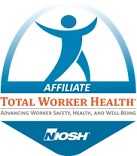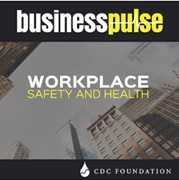Total Worker Health in Action!
Volume 5 Number 1 February 2016

In this issue:
- Managers’ Buzz
- Total Worker Health Exclusive
- Updates from the NIOSH Office for Total Worker Health
- Updates from NIOSH Centers of Excellence for Total Worker Health
- News from NIOSH Total Worker Health Affiliates and Partners
- New Publications and Resources
- Conferences, Webinars, and Trainings in Support of Total Worker Health
- Contributors
Managers’ Buzz
Anita L Schill, PhD, MA, MPH, and L Casey Chosewood, MD, MPH

In December, the Office for Total Worker Health participated in its first-ever National Institutes of Health hosted Pathways to Prevention Workshop. The workshop, titled Total Worker Health®—What’s Work Got to Do With It?, brought together experts in this emerging field to discuss the state of the scientific evidence for Total Worker Health. More than 700 people attended the two-day live event or participated by webcast, making this the most widely attended event in the history of the TWH program. We’d like to take the time to thank the workshop organizers, presenters, panelists, and audience members for making the workshop a success. Your continued interest and support inspire the TWH team to keep pushing forward with our efforts to safeguard workers and improve their opportunities for greater health and well-being.

During the workshop, we listened to presenters who commented on the significant diversity of integrated interventions, the lack of standardization of methods and approaches for research, and the need for additional research examining the impact of integrated health, safety, and well-being programs. Presenters also noted that researchers took varied approaches when assessing integrated programs, which impacted the ability to draw conclusions about the feasibility, quality, effectiveness, and scalability of interventions. Although these comments reflect that Total Worker Health is a relatively new field, they also underscore the importance of continuing to fund additional research in this area. This field of research needs a deeper and more robust scientific evidence base and greater attention to methodological approaches for obtaining it.
Within a week after the conclusion of the event, the workshop panel drafted a report containing recommendations for advancing the science of Total Worker Health. These draft recommendations will be carefully considered as Total Worker Health plans future investments and projects, and as we finalize the National Total Worker Health Agenda.
We are taking the workshop’s recommendations seriously. We have already begun planning for an in-depth research methodology workshop in the year ahead to advance the quality, quantity, and standardization of research in this field and to set research priorities. The methodology workshop will offer guidance for researchers hoping to explore Total Worker Health approaches in systematic ways so that results can be compared across studies. Read more about the panel’s draft recommendations in the TWH Exclusive.
As Total Worker Health continues to respond to the latest research and input from our stakeholder community, we invite you to join in the conversation on Twitter (@NIOSH_TWH), on the NIOSH Total Worker Health LinkedIn Group, or by email at twh@cdc.gov.
Total Worker Health Exclusive
Recap: NIH Pathways to Prevention Workshop
The Total Worker Health—What’s Work Got To Do with It? Pathways to Prevention Workshop in December offered an opportunity to look critically at the state of the scientific evidence for Total Worker Health. Our gratitude goes to our partners at the National Institutes of Health Office of Disease Prevention and the National Heart, Lung, and Blood Institute for co-sponsoring this event. We also thank the panelists, audience members, and many contributors who made the workshop a success.
Presenters and workshop panelists focused on addressing the following key questions to assess research gaps and future directions for Total Worker Health:
- What studies exist assessing integrated interventions?
- What are the known benefits and harms of integrated interventions?
- What are the characteristics of effective integrated/combined interventions and programs?
- What factors influence the effectiveness of integrated interventions?
- What are the key evidence gaps?
Presenters commented on the need for studies exploring systems-level and organizational-level changes in workplaces implementing integrated approaches to safety, health, and well-being. In addition, presenters emphasized the need for additional research in different types of workplaces—varying in size, organizational structure, and industry. The workshop panel’s draft report highlights that the literature on integrated interventions is limited and the effectiveness of integrated interventions from this research is just beginning to emerge. Although the panel’s final report will be published later in 2016 in the Annals of Internal Medicine, its draft report offers areas of consideration for Total Worker Health and integrated approaches to workplace safety, health, and well-being. Draft recommendations from the panel include the following:
| Draft Recommendations from NIH Pathways to Prevention Workshop Panel | |||||||
|---|---|---|---|---|---|---|---|
| Convene a meeting of stakeholders to set research priorities for integrated interventions. | Develop a consensus-based conceptual framework to guide future intervention research. | Develop a core set of measures and outcomes that are incorporated into all integrated intervention studies. | Use a transdisciplinary and participatory process for intervention development. | Ensure that future intervention studies represent an appropriate range of worker populations and settings. | Expand research and evaluation design options to include a range of rigorous methodologies. | Develop effective strategies for timely dissemination of findings to a wide variety of stakeholders. | Make investments in research infrastructure and assets to develop population-based laboratories for TWH research. |
As Total Worker Health continues to grow in its evidence base and support, the discussion from the Pathways to Prevention workshop will shape directions for future research and for Total Worker Health. If you missed the workshop, archived videocasts are available now.
Updates from the NIOSH Office for Total Worker Health

Are you part of an academic institution, labor organization, public sector entity, or non-profit association related to occupational safety and health? NIOSH’s Office for TWH welcomes interested groups in these categories to consider becoming TWH Affiliates. The NIOSH TWH Affiliate Program seeks to foster an integrated approach to protecting and promoting worker safety, health, and well-being through collaborations with public and not-for-profit organizations. Affiliates may have opportunities to conduct joint research, collaborate on speaking and educational events, and create and disseminate communications products. Currently there are 17 TWH Affiliates. You can view the full list of TWH Affiliates here. Interested in becoming a NIOSH TWH Affiliate? Contact the NIOSH Office for TWH at twh@cdc.gov.
The recording of “Advancing Working Family Well-Being”, the first NIOSH Total Worker Health Webinar of 2016, is now available for viewing. The presentation featured Dr. Pamela Winston of the Office of the Assistant Secretary for Planning and Evaluation in the U.S. Department of Health and Human Services, Carol Joyner of the Labor Project for Working Families, and Dr. Erin Kelly of the Institute for Work and Employment Research of the MIT Sloan School of Management. Presenters provided background on research findings and policy trends related to work-family issues. They described evidence of how work-family policies may benefit the health of working parents and their families, as well as the benefit to employers. Finally, presenters offered employer-driven and organizational-level guidance that workplaces can implement to better support working family well-being. To watch the free recording or for more on the NIOSH Total Worker Health Webinar Series, please visit the NIOSH TWH Webinar Series webpage.
Updates from NIOSH Centers of Excellence for Total Worker Health
The Center for the Promotion of Health in the New England Workplace (CPH-NEW)
Save the Date! CPH-NEW will co-sponsor a conference at the University of Connecticut Storrs Campus called Participatory Action Research: Researchers and community partners working together for real-world success. The conference will be held the afternoon of March 30, 2016, from 12:30 to 4:30 Eastern time. This forum will provide an opportunity to hear real-world examples of action research in community and workplace settings. Join CPH-NEW for a keynote address, panel presentations, and roundtable discussions to learn about what works and how to avoid common pitfalls. Attendees will also hear results of the two CPH-NEW 2014 pilot grant projects, one on commuting stress and one on custodial worker safety and health. Check the CPH-NEW Events Page for more information. In addition, two new emerging topic briefs are featured in CPH News and Views, on Workplace Bullying, Consequences, and Solutions and Occupational Health and Safety Hazards in Child Care Work.
Harvard T.H. Chan Center for Work, Health and Well-being
In January the Center brought the Total Worker Health perspective to the HealthLead Forum, sponsored by U.S. Healthiest and the Centers for Disease Control and Prevention. The Forum theme was ‘the bottom line future of worksite health and well-being.’
The Center’s annual Executive Continuing and Professional Education Course is being held in February in Boston, MA with Dr. John Howard, NIOSH Director, as one of the keynote speakers. It features a program entitled Work, Health, and Well-Being: Integrating Wellness and Occupational Health and Safety in the Workplace. Participants will learn to integrate policies, programs, and practices into a comprehensive program that enhances the overall health and well-being of the workforce and reduces work-related injuries and illnesses. This program will provide participants with the skills needed for specific efforts:
- Evaluating worksite and worker health risks
- Translating occupational health and safety research into practice
- Measuring outcomes and evaluating health and safety programs, and
- Assessing the financial impact of workplace health programs.
For more information, please visit the program website.
University of Iowa Healthier Workforce Center for Excellence (HWCE)
The Healthier Workforce Center at the University of Iowa continues its outreach and education efforts by continually expanding partnerships with other organizations who show a commitment to Total Worker Health®. Recent partnerships include the City of Marion, Iowa Blue Zones Project.
On April 1, the University of Iowa will host the first annual Student Occupational Safety and Health Symposium. The event is co-sponsored by the CDC-funded Injury Prevention Research Center and three NIOSH-funded centers: the Healthier Workforce Center for Excellence, the Great Plains Center for Agricultural Health, and the Heartland Center for Occupational Health and Safety. The symposium provides graduate students an opportunity to present on research, surveillance, education, outreach, and intervention related to occupational safety and health. The agenda includes an outside speaker (to be announced), six student platform presentations, and time for poster presentations. Awards for outstanding platform and poster will be presented during the closing session of the symposium.
Oregon Healthy Workforce Center (OHWC)
In upcoming events at the OHWC, the 2016 Occupational Health Psychology (OHP) Summer Institute is scheduled for July 12-14, 2016. Learn more about OHP Innovation and Creative Strategies Leading to Total Worker Health on the OHWC website, where you can also register for the event. The center’s fall symposium,on Mindfulness and Total Worker Health (November 20, 2015), was a tremendous success. OHWC thanks the symposium speakers—Autumn Krauss of Sentis; Richard Goerling of Pacific University; Susy Reiner and Capt. Robert Wenz of Alaska Tanker; and Robert Roeser of Portland State University—for their contributions. Handouts and recorded webinars are available on the symposium website.
News from NIOSH Total Worker Health Affiliates and Partners

The CDC Foundation recently released a Business Pulse highlighting workplace safety and health. Quarterly, CDC Foundation’s Business Pulse covers topics relevant to protecting “businesses and their workforces—from chronic threats that impact health and productivity to major health emergencies.” The latest issue was developed in conjunction with NIOSH. The interactive Business Pulse on Workplace Safety and Health explores how CDC helps employers protect America’s changing workforce from work-related injury and illness while addressing emerging safety and health challenges, including shifting employment relationships, workplace stress disorders, an aging workforce, and chronic diseases. The Business Pulse features an infographic, question-and-answer sessions with industry experts, and resources for businesses around worker safety, health, and well-being.
The Center for Health, Work and Environment at the Colorado School of Public Health is excited to be expanding one of its signature programs, Health Links, to Florida in February. Health Links partners with public health agencies and stakeholder groups to provide organizations with advising, Healthy Business certification, and connection to local resources that help improve health, safety, and well-being at work. The Florida Department of Health in Manatee County will serve as the home office for Health Links Florida.
New Publications and Resources
Free Podcast: Worker Health and the New Global Economy
What’s different about the new economy and new workplace today, compared to the past? What science-based solutions and innovative employer strategies can businesses use to address emerging safety and health issues? In this 20-minute interview featured on Working Capital Conversations, Dr. L. Casey Chosewood discusses issues such as temporary or contingent work, work-influenced chronic disease, and an aging workforce. He also gives practical strategies for employers who wish to move toward a Total Worker Health approach.

NIOSH Center for Motor Vehicle Safety Older Driver Fact Sheet
NIOSH’s Center for Motor Vehicle Safety will be releasing “Older Drivers in the Workplace,” a fact sheet which gives employers and workers information on age-related physical and mental changes that may affect older workers’ ability to drive safely. To view and share the fact sheet, please visit the NIOSH Center for Motor Vehicle Safety. The image to the right is a clip from the fact sheet.
Total Worker Health In Depth Video Series: Transportation Safety
The Healthier Workforce Center at the University of Iowa continues its outreach and education efforts through the Total Worker Health® In Depth video series. Short videos on workplace safety and transportation safety were recently released, and other topical videos are currently in production.
Resource for Child Care Providers
The Northern Kentucky Health Department, in partnership with the NIOSH Small Business Assistance Program, has developed a new manual for workers in early care environments. Total Worker Health: Staff Wellness and Safety in the Child Care Setting is tailored to the personal health and safety needs of child care providers in early care environments. The resource outlines a step-by-step program that combines assessment, training, and education for sustainable change in addressing job-related hazards and overall worker health. Included are initial and post-environmental assessments with questions on availability of workplace healthy food options, worksite opportunities for physical activity, ergonomics, and work organization tools to decrease stress. The program also provides ergonomics handouts, slides, and a Trainer’s guide.
4 New Publications from Centers of Excellence for Total Worker Health
Facilitators and barriers to using treadmill workstations under real working conditions: a qualitative study in female office workers: Through the use of qualitative interviews, researchers at CPH-NEW examined factors that enabled or inhibited treadmill workstation use amongst female office workers. Researchers found that inherent lack of job control was a significant barrier among this group of workers.
Participatory action research in corrections: the HITEC 2 program: (epub ahead of print). Researchers at CPH-NEW examined participatory action research methods by comparing two intervention approaches at correctional facilities: the first used Kaizen effectiveness teams, and the second used design teams.
Participatory design of integrated safety and health interventions in the workplace: a case study using the Intervention Design and Analysis Scorecard (IDEAS) tool: In this case-study from CPH-NEW, maintenance technicians at a property management firm utilized the IDEAS tool to develop and execute safety and health interventions.
Research Needs for and Barriers to Use of Treadmill Workstations: Researchers at CPH-NEW investigated research gaps in testing treadmill workstations at real workplaces. In addition, they offer suggestions for investigation of the adoption of treadmill workstations in workplaces.
Conferences, Webinars, and Trainings in Support of NIOSH Total Worker Health
February
2nd—Dr. L. Casey Chosewood presented at The Colorado School of Public Health’s Environmental and Occupational Health Seminar Series and to students at the University of Colorado Center for Worker Health and Environment, in Denver.
4th—Ms. Chia-Chia Chang will present a session on TWH to safety professionals at the North Dakota Safety Council’s Safety and Health Conference, titled Advancing Worker Well-Being: The “Why” and the “How”.
12th—Dr. Diane Rohlman, of University of Iowa HWCE, will present Creating Safer and Healthier Workplaces Through Total Worker Health® at the Corridor Business Journal Health Care Summit in Cedar Rapids, IA.
March
9th to 11th—Dr. L. Casey Chosewood will present Seven Critical Strategies for Improving the Health, Safety, and Well-being of Your Workforce at the 2016 Ohio Safety Congress & Expo in Columbus, Ohio.
21st to 24th—Dr. L. Casey Chosewood will present a workshop, entitled Strategies for Healthier Work and a Healthier Life: Applying the Total Worker Health Approach, at the 4th International Strategy Conference on Safety and Health at Work in Dresden, Germany.
April
29th—Dr. Diane Rohlman of University of Iowa HWCE will present Creating Safer and Healthier Workplaces Through Total Worker Health® at the Roadmap to a Healthier Workplace Summit, Western Kentucky University, in Bowling Green, KY.
2017
SAVE THE DATE for Work, Stress, and Health 2017
The 12th International Conference on Occupational Stress and Health, “Work, Stress, and Health 2017: Contemporary Challenges and Opportunities,” will be held at the Hotel Minneapolis in Minneapolis, Minnesota from June 7 to 10, 2017. Details and the forthcoming Call for Papers can be found on the conference website: http://www.apa.org/wsh. Don’t forget to mark your calendars, and in the meantime learn about the rich arts and culture, dining, shopping, and outdoor activities that WSH 2017’s host city has to offer.
Contributors
Editorial Board
L. Casey Chosewood, MD, MPH, Executive Editor
Anita L. Schill, PhD, MA, MPH, Executive Editor
CDR Heidi Hudson, MPH, Editor in chief
Reid Anderegg, Managing Editor
Michelle Lee, Associate Editor
Seleen Collins, Copy Editor
Tonya White, NIOSH Web Publisher
Steve Leonard, NIOSH Web Publisher
Please send your comments and suggestions to us at twh@cdc.gov
This newsletter is published quarterly via email by the National Institute for Occupational Safety and Health Total Worker Health® Program to inform members of the public health community as well as interested members of the general public of program-related news, new publications, and updates on existing activities and initiatives.
Get Email Updates
To sign up to receive the TWH Newsletter, enter your email address:
- Page last reviewed: January 27, 2016
- Page last updated: January 27, 2016
- Content source:
- National Institute for Occupational Safety and Health Office of the Director
TOTAL WORKER HEALTH ® is a registered trademark of the US Department of Health and Human Services


 ShareCompartir
ShareCompartir
